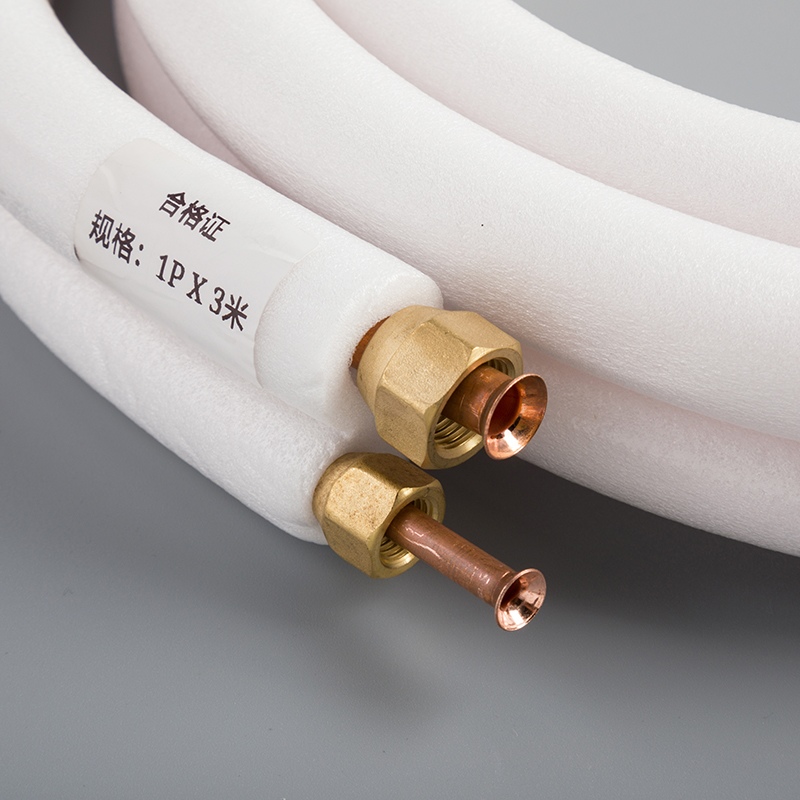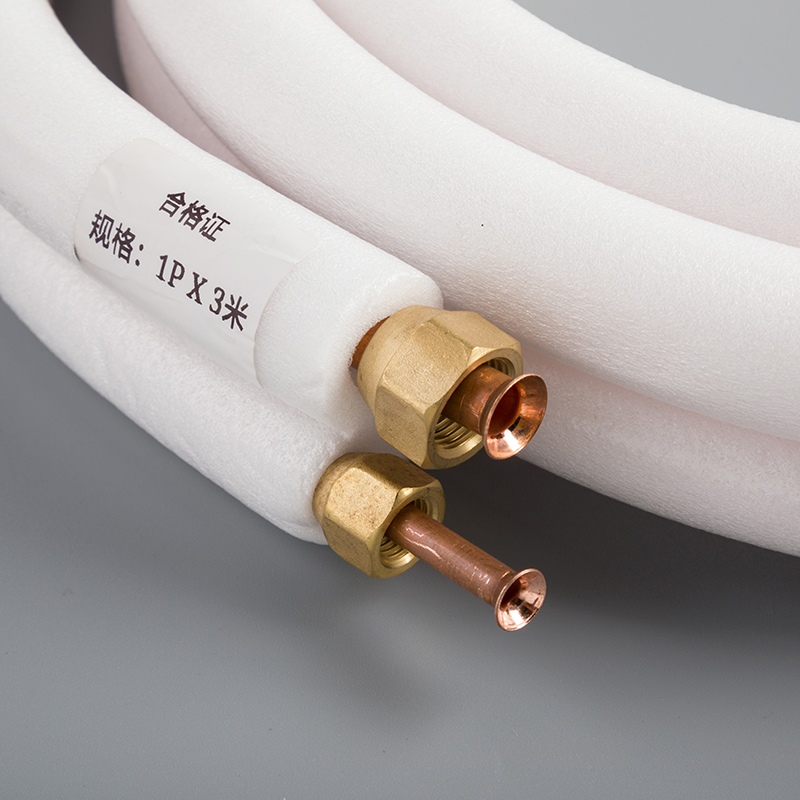Effective Tips to Lower AC Copper Pipe Costs

To effectively manage Tips to Reduce the Cost of Air Conditioning Copper Pipes, understanding the key cost factors is crucial. Factors like material quality, pipe dimensions, and installation complexity significantly impact expenses. By optimizing these aspects, individuals can lower their AC copper pipe costs efficiently. Reducing these expenses not only saves money in the short term but also enhances long-term savings. Implementing cost-saving strategies can lead to improved financial stability and increased efficiency in air conditioning systems.
Understanding AC Copper Pipe Costs
When considering Tips to Reduce the Cost of Air Conditioning Copper Pipes, it is essential to delve into the factors that influence expenses directly. The quality of materials used plays a significant role in determining the overall cost. Opting for high-quality copper tubes can lead to more sustainable and cost-effective solutions for air conditioning systems.
Factors Influencing Costs
Material Quality
Selecting premium-grade copper tubes ensures durability and longevity.
High-quality materials contribute to reducing maintenance costs over time.
Investing in superior copper pipes minimizes the risk of frequent replacements.
Pipe Length and Diameter
Choosing smaller diameter tubes optimizes HVACR efficiency and reduces internal volume.
Smaller pipes can enhance the overall performance of air conditioning systems efficiently.
Properly sizing pipes based on length and diameter requirements can lead to cost savings.
Installation Complexity
Simplifying installation processes can help lower labor costs associated with copper pipe installations.
Ensuring straightforward installation procedures reduces overall expenses effectively.
Streamlining complex installations enhances cost-efficiency in air conditioning projects.
Market Trends
Seasonal Price Fluctuations
Being aware of seasonal price variations allows for strategic planning when purchasing copper pipes.
Monitoring market trends enables individuals to capitalize on cost-saving opportunities during favorable periods.
Adjusting procurement strategies based on seasonal fluctuations can result in substantial savings.
Supply and Demand Dynamics
Understanding supply and demand dynamics is crucial for negotiating favorable prices with suppliers.
Aligning procurement practices with market demands helps optimize cost management strategies effectively.
Adapting to changes in supply and demand ensures a competitive edge in acquiring affordable copper piping materials.
Inspection and Maintenance

To ensure the longevity and efficiency of air conditioning systems, regular maintenance and inspections are essential. By following these guidelines, individuals can prevent costly repairs and maintain optimal performance.
Regular Inspection
Identifying Wear and Tear
Inspect copper pipes regularly to detect any signs of wear or damage.
Look for corrosion or discoloration on the surface of the pipes.
Check for bending or kinking along the length of the tubes.
Checking for Leaks
Conduct a thorough examination to identify any leaks in the system.
Look for moisture accumulation around joints or connections.
Use a leak detection kit to pinpoint any hidden leaks within the copper pipes.
Maintenance Tips
Cleaning and Flushing Pipes
Clean copper pipes periodically to remove dirt and debris that can affect performance.
Use a mild solution of water and vinegar to flush out any blockages in the tubes.
Consider using a specialized pipe cleaning brush to reach inaccessible areas.
Ensuring Proper Insulation
Insulate copper pipes properly to prevent heat loss during operation.
Utilize foam insulation sleeves to cover exposed sections of the tubes.
Ensure that all joints and fittings are securely sealed with insulating tape.
Regular Servicing of the Air Conditioner
Schedule routine service appointments with a certified technician to maintain your air conditioner.
Have the professional check for refrigerant levels, compressor efficiency, and overall system performance.
Address any issues promptly to avoid costly repairs in the future.
Preventive Measures
Proper Installation Techniques
To ensure the efficiency and longevity of air conditioning systems, individuals must adopt proper installation techniques. By utilizing correct tools and materials, following manufacturer guidelines, and implementing proper brazing methods, they can prevent costly issues in the future.
Using Correct Tools and Materials
Select appropriate tools for copper pipe installations to guarantee precision.
Ensure that all materials meet industry standards for quality and durability.
Verify the compatibility of tools with copper pipes before commencing installation.
Following Manufacturer Guidelines
Refer to the manufacturer's instructions for accurate installation procedures.
Adhere strictly to recommended guidelines to avoid errors during the process.
Consult with professionals if unsure about any specific instructions provided.
Proper Brazing to Prevent Leaks
Employ proper brazing techniques to secure joints effectively.
Inspect brazed connections thoroughly to detect any potential leaks.
Test the integrity of brazed areas to ensure airtight seals are maintained.
Protective Coatings
Applying protective coatings on copper pipes is essential to enhance their durability and resistance against external factors.
Types of Coatings
Utilize anti-corrosion coatings to protect copper pipes from environmental elements.
Consider using insulating coatings to improve energy efficiency within air conditioning systems.
Application Methods
Apply coatings evenly on the surface of copper pipes using specialized tools.
Allow sufficient drying time as per coating manufacturer recommendations.
Inspect coated pipes regularly for signs of wear or damage.
Problem-Solving Strategies
Addressing Common Issues
Corrosion Prevention
To prevent corrosion in copper pipes, individuals should regularly inspect the pipes for any signs of deterioration.
Applying anti-corrosion coatings on the surface of copper tubes can effectively protect them from environmental elements.
Utilizing proper insulation techniques can also contribute to preventing corrosion by reducing exposure to moisture and external factors.
Leak Repairs
When addressing leaks in copper pipes, it is essential to identify the source of the leak accurately.
Conduct a thorough inspection to locate the exact point of leakage within the copper piping system.
Employ suitable repair methods based on the size and severity of the leak to ensure long-lasting solutions.
Cost-Effective Solutions
DIY vs. Professional Services
Individuals can opt for do-it-yourself (DIY) solutions for minor repairs and maintenance tasks on their air conditioning copper pipes.
Seeking professional services for complex issues or major installations can ensure quality workmanship and long-term reliability.
Balancing between DIY approaches and professional assistance can help individuals manage costs effectively while maintaining system efficiency.
Sourcing Affordable Materials
When sourcing materials for air conditioning projects, consider exploring various suppliers to compare prices and quality.
Look for discounts or promotions offered by reputable vendors to acquire affordable yet high-quality copper piping materials.
Prioritize purchasing from reliable sources that guarantee product authenticity and adherence to industry standards.
Additional Cost-Saving Tips
Home Insulation and Sealing
Sealing Windows and Doors
Seal windows and doors effectively to prevent air leaks that can lead to energy wastage.
Use weather stripping or caulking around windows and doors to create a tight seal.
Prevent cold drafts in winter and hot air infiltration in summer by sealing all gaps securely.
Evaluating Home Insulation
Evaluate the insulation in your home to ensure it meets recommended standards for energy efficiency.
Check the attic, walls, and floors for adequate insulation levels to maintain a comfortable indoor environment.
Upgrade insulation where needed to reduce heat transfer and improve overall energy conservation.
Smart Thermostats and Ceiling Fans
Installing a Smart Thermostat
Install a smart thermostat to regulate temperature settings efficiently based on your schedule.
Program temperature adjustments for different times of the day to optimize energy usage.
Control your HVAC system remotely through smart features that enhance convenience and savings.
Using Ceiling Fans to Circulate Air
Utilize ceiling fans to circulate air throughout rooms and maintain consistent temperatures.
Adjust fan direction seasonally; clockwise in winter for warmth distribution, counterclockwise in summer for cooling effects.
Increase comfort levels by using ceiling fans alongside your air conditioning system without compromising efficiency.
Energy-Saving Practices
Raising the Temperature Slightly
Increase the thermostat setting by a few degrees during warmer months to reduce cooling costs.
Find a balance between comfort and energy savings by adjusting temperatures gradually over time.
Opt for higher temperatures when away from home or during sleeping hours to save on electricity consumption.
Closing Curtains to Block Sunlight
Close curtains or blinds during peak sunlight hours to minimize heat gain inside your home.
Use light-colored window treatments that reflect sunlight rather than absorbing heat.
Reduce the strain on your air conditioner by shading windows effectively with curtains or blinds.
Locating and Sealing Drafts
Identify drafty areas around windows, doors, and vents by feeling for airflow with your hand.
Seal drafts using weather stripping, door sweeps, or caulk to prevent conditioned air from escaping.
Enhance indoor comfort by eliminating drafts that contribute to increased energy usage.
Opening Windows at Night
Take advantage of cooler nighttime temperatures by opening windows for natural ventilation.
Promote cross ventilation within your home by strategically placing open windows for optimal airflow.
Improve indoor air quality while reducing reliance on mechanical cooling systems during mild evenings.
Avoiding Cooking Inside
Minimize indoor heat generation during hot weather by avoiding cooking with stovetops or ovens excessively.
Opt for quick meals that require minimal cooking time or consider using outdoor grilling options when possible.
Recapping the essential points highlighted throughout the blog, prioritizing cost-effective strategies is key to long-term financial stability. Emphasizing the benefits of reducing AC copper pipe costs not only ensures immediate savings but also enhances efficiency over time. Encouraging the implementation of provided tips can lead to substantial financial gains and improved system performance. Maintaining a focus on efficiency and cost-effectiveness guarantees sustainable air conditioning solutions for a comfortable and budget-friendly environment.
See Also
Cut Costs on Air Conditioner Copper Tubing with 5 Tips
Maximize Air Conditioner Efficiency with Copper Pipe Insulation Secrets
Maintain Peak Efficiency of Copper Pipes with Comprehensive Guide
Benefits of Selecting Copper Pipes for Air Conditioning Systems
Exploring Eco-Friendly Options as Alternatives to Copper AC Tubing


